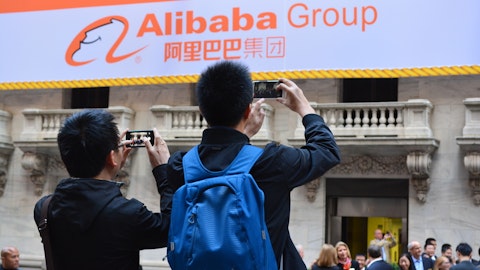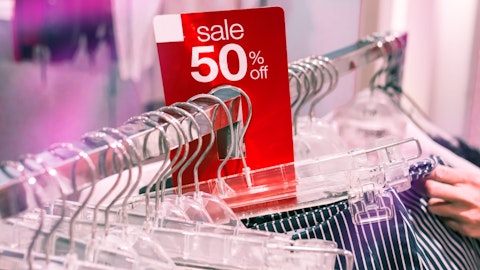So that helps us. It allows us to invest as we go into Labor Day and Fall planning and Fall harvest, Halloween holiday, those types of things so that we can continue to provide value that way to the consumer with those holiday sets and Halloween sets provide a transition in the stores, as you know, and gives the customer some excitement. And then we’ve got a lot of new stuff that we’ve talked about. We’ve got Coca-Cola that will finish rolling out in our stores, being able to have access to that entire portfolio of product we’re excited about. We’ll roll out Carhart to 250 stores in Q3. So we’re excited about getting that out there for both the DIY and the Pro. And then we’ll have some new stuff in that spooky area for Halloween for the Halloween enthusiasts.
So all of that try to provide value to our customers in lots of different ways. And then offer them those promotional offers in appliances like you have to provide because over 100,000 appliances break every single day, and we want to make sure that we’re relevant out there, and try to manage all of it in a portfolio approach. So we’ve got a lot of stuff going. We’re excited about it, and we think will give us a nice way to position ourselves to drive value for our customers through the back half of the year and into next year.
Eric Bosshard: Okay. And then second question, if I could. As you — Brandon did a good job of explaining that you’ve kind of cycled through the price increases, and there’s minimal from here. The math of the past couple of years has been price up more than volume has been down. I’m just curious how you all think about as price no longer goes up, the path for volume turning from a negative to a positive, I’m just curious how you think about that, and what makes that happen and perhaps when?
Brandon Sink: Yes, Eric, this is Brandon. I think again, focus right now on 2023. As I mentioned earlier, we have kind of broken down transactions in ticket. We do expect pressure on transactions as we move across the balance of the year ticket to hold. I do think when we get on the backside of this, I’m not going to put a time frame on it, obviously, as there’s a bunch of variables, a lot of uncertainty. It’s too early for us to call what 2024 is going to look like. But I do think we are expecting a convergence in a better balance of transactions and ticket probably similar to pre-COVID levels as we start to look ahead across the long-term.
Marvin R. Ellison: This is Marvin. The only thing I’ll add to that is we still are in the early innings of making what I would call best-in-class business operations in our omni channel area, in localization, and in just the overall technology infrastructure. I’ve mentioned that we’re retiring a 30-year-old operating system. And not only will that make our stores a lot easier to operate from a technology standpoint, but what it does, it gives us incredible agility to build on top of that modern platform for more omni channel capabilities. There’s a lot of things we’re doing today, the hard way. And so I get excited because I can get out of bed every day, and I can see a long list of initiatives that we have yet to get to that’s going to drive operating margin improvement, drive space productivity, and hopefully will drive top line as consumer sentiment continues to improve.
So we’re confident that we’ve not even reached a point of peak performance relative to the investment cycle that we have because we’ve been other places, we know what world class looks like, and we know that we’re on a journey to get there, but there are still areas of our business: Pro, online, fulfillment capabilities, space productivity that we know that we’re still in the early innings. And so that’s exciting, and we just have to do the work to make sure that we can achieve the expectations we have. And Rob, we have time for one more question.
Operator: Thank you. The final question will be from Steven Zaccone with Citi. Please proceed with your questions.
Steven Zaccone: Good morning, thanks very much for squeezing me in. I wanted to circle back to your commentary about the appliance promotions, could you elaborate on that a bit more, it sounds new, what are your expectations for that side of the business in the second half of the year? And then just a follow-up on the promotions question earlier, it seems like the industry has not needed to be promotional, how long do you think this can last if big-ticket discretionary weakness continues?
William P. Boltz: Yes. So Steve, this is Bill. So just on the appliance side, specifically, what we’ve seen with appliances is that really, the industry has returned to kind of a more normalized go-to-market promotional offering, similar to what you saw prior to the pandemic. And so this normalization, as I said in my remarks, has put pressure on average ticket and average selling price across the industry. Everybody, I think, is feeling that impact. But essentially, we cycle this as we get into Q4, and we get into more of an apples-to-apples comparison when we get to Q4. But we’re excited about the strength that we’ve seen with our appliance business. First quarter track line data would indicate that we took share in the first quarter.
So we’re driving units and trying to make sure that we can meet the needs of our consumers is, like I said, in Eric’s question, 100,000 appliances break every single day, we’ve got to be there for our consumer. But it’s not a radical shift to heavy promotions. It’s more of a normalized promotion.
Steven Zaccone: Got it. And then just question on the back half margins for you, Brandon. Given the commentary about same-store sales in the third quarter, is there anything to be mindful of in terms of gross margin or SG&A cadence in the third quarter versus the fourth quarter?
Brandon Sink: No. I would say, Steven, still expect 40 to 60 basis points of expansion. The one thing that I would call out, I mentioned we expect the PPI benefits to build over the second half. And then the second thing I’ll mention is we are cycling over $400 million of associate discretionary bonuses that were paid out last year that we’re not expecting to recur. So those are the big items that I would call out as we move through the second half.
Marvin R. Ellison: And Steve, I would be remiss if I didn’t just talk a little bit about our performance and shrink and the most difficult retail environment for shrink in my 35 years in this space. I want to let Joe just talk a little bit about the successes that we’re seeing and how we hope that continues to support our gross margin forecast for the back half of the year.
Joseph M. McFarland III: Thanks, Marvin. And let me give you just a quick shout out to the store operations team and really our asset protection team. I believe they are best in class. And as you look across the actions that we’ve taken, whether it’s in supply chain, whether it’s on the front end with our new proprietary self-checkouts replacing the MCRs, we have a best-in-class awareness platform that’s got a 92% voluntary participation rate. And that we have a line of sight for front-end transformations as we move into next year. The 100% execution of our high-strength program, where we’ve identified the stores. And so I feel really confident and just a great job by the team.
Kate Pearlman: Thank you all for joining us today. We look forward to speaking with you on our third quarter earnings call in November.
Operator: Thank you. This concludes the Lowe’s second quarter 2023 earnings call. You may now disconnect.
Follow Lowes Companies Inc (NYSE:LOW)
Follow Lowes Companies Inc (NYSE:LOW)
Receive real-time insider trading and news alerts





